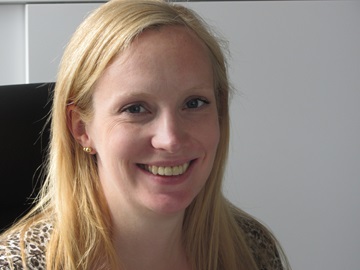”The ultimate aim is to be able to bind cells in different locations in a culture dish, and, bit by bit, to culture entire organs. But we’re not there yet”, says Kristin Persson, who recently presented her doctoral thesis in organic electronics.
Kristin Persson belongs to that part of Professor Magnus Berggren’s research group that is investigating the links between biology, chemistry and electronics – also called bioelectronics. The various aspects of the research have been conducted together with researchers in organic chemistry and clinical and experimental medicine at Linköping University, as well as with researchers from Karolinska Institute and the University of Utah.
 Foto: Monica Westman
Foto: Monica Westman
”But different cells behave differently, so you can’t use one solution for all cell types”, Dr Persson says.
In one of the articles from the thesis, Dr Persson shows that it is possible to control the differentiation of stem cells. Surfaces consisting of the conductive polymer PEDOT and the polysaccharide Heparin were used to study the growth factors that adhere to Heparin and that also affect the differentiation of stem cells.
When applying a positive potential to the PEDOT/Heparin surface, the volume of available growth factors increased three- to five-fold on the reduced side. The Heparin, and thus also the growth factors, were exposed on the surface because they were not firmly bound to the PEDOT substrate.
However on the oxidised side, both the Heparin and the growth factors were firmly bound and the stem cells differentiated.
”A shortage of growth factors of this type causes the stem cells to differentiate and a large number of growth factors causes them to remain undifferentiated”, explains Dr Persson.
”We hope that our method of detaching cultured skin will be a good complement to the methods currently in use.”
In the final article, Dr Persson and colleagues have also attempted to culture skin using a matrix where the potential can be varied in different parts.
”When culturing skin from a patient, you get a number of different cells, and using the matrix we can select the cells we are interested in culturing”, she explains.
What is the next step?
”We have been able to prove that we can control the events separately, but we also want to show that we can control the entire chain: adhesion, how and where the cells adhere to the conductive polymer, growth and detachment. We haven’t started testing that yet”, says Dr Persson, who will continue for at least another six months at the Laboratory of Organic Electronics.
Related links
Electronic control of cell cultures using conjugated polymer surfaces, Kristin Persson, Department of Science and Technology, Linköping University, Campus Norrköping, 2014.
Surface switch turns on cell culture
Laboratory of Organic Electronics
2014-06-13
Kristin Persson belongs to that part of Professor Magnus Berggren’s research group that is investigating the links between biology, chemistry and electronics – also called bioelectronics. The various aspects of the research have been conducted together with researchers in organic chemistry and clinical and experimental medicine at Linköping University, as well as with researchers from Karolinska Institute and the University of Utah.
Possible to take control
A few pieces of the organ construction are in place. Dr Persson and her colleagues have shown it is possible to control the culturing of cells by culturing them on different types of conducting polymers. When applying a positive potential to the culture dish, a particular type of cell adheres better at the positive pole, the oxidised side, and another at the negative pole, the reduced side. The continued growth of the cells is also affected; some cell types do very well at one side, while others enter apoptosis – they ”commit suicide”. Foto: Monica Westman
Foto: Monica Westman”But different cells behave differently, so you can’t use one solution for all cell types”, Dr Persson says.
In one of the articles from the thesis, Dr Persson shows that it is possible to control the differentiation of stem cells. Surfaces consisting of the conductive polymer PEDOT and the polysaccharide Heparin were used to study the growth factors that adhere to Heparin and that also affect the differentiation of stem cells.
When applying a positive potential to the PEDOT/Heparin surface, the volume of available growth factors increased three- to five-fold on the reduced side. The Heparin, and thus also the growth factors, were exposed on the surface because they were not firmly bound to the PEDOT substrate.
However on the oxidised side, both the Heparin and the growth factors were firmly bound and the stem cells differentiated.
”A shortage of growth factors of this type causes the stem cells to differentiate and a large number of growth factors causes them to remain undifferentiated”, explains Dr Persson.
Electronic glue
The next step is to try to detach the cells from the substrate – the conductive plastic. This requires the efforts of organic chemists from Linköping University, to develop a water-soluble, stable variant of PEDOT. In the fourth article from the thesis Dr Persson shows that when the polymer surface oxidises, it breaks into small pieces and the cultured cells detach.”We hope that our method of detaching cultured skin will be a good complement to the methods currently in use.”
In the final article, Dr Persson and colleagues have also attempted to culture skin using a matrix where the potential can be varied in different parts.
”When culturing skin from a patient, you get a number of different cells, and using the matrix we can select the cells we are interested in culturing”, she explains.
What is the next step?
”We have been able to prove that we can control the events separately, but we also want to show that we can control the entire chain: adhesion, how and where the cells adhere to the conductive polymer, growth and detachment. We haven’t started testing that yet”, says Dr Persson, who will continue for at least another six months at the Laboratory of Organic Electronics.
Related links
Electronic control of cell cultures using conjugated polymer surfaces, Kristin Persson, Department of Science and Technology, Linköping University, Campus Norrköping, 2014.
Surface switch turns on cell culture
Laboratory of Organic Electronics
2014-06-13
